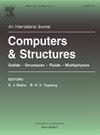自适应等距齿轮接触分析:几何生成、截断分层 B 样条细化和验证
IF 4.4
2区 工程技术
Q1 COMPUTER SCIENCE, INTERDISCIPLINARY APPLICATIONS
引用次数: 0
摘要
齿轮是应用最广泛的传动部件之一。它们的运行依赖于配合齿轮齿面之间的接触来传递动力。准确预测这些区域的接触应力对于这些系统的设计和尺寸确定至关重要。齿轮设计以高度平滑的渐开线曲线为中心,而渐开线曲线对齿轮的接触性能有很大影响。本文介绍了一种基于分层样条的完全自适应等距接触建模方案,并将其应用于模拟齿轮接触问题。特别是,将一对啮合的齿轮齿视为线性弹性体,对其进行等距模拟建模。根据工程设计参数自动生成齿轮的边界拟合 B-Spline 表示,并用于定义初始离散化基础。使用所谓的高斯点到面公式和最近点投影程序对接触区域进行数值积分。截断分层 B-样条曲线用于捕捉接触的高度局部性,同时有效减少自由度数量。自适应能力由应变能量密度梯度驱动,它允许在不预先了解齿面接触区域的情况下自动定位网格。在实验中,我们对算法不同步骤中的选择进行了论证,并评估了自适应求解器与传统张量乘积 B-样条曲线的性能。本文章由计算机程序翻译,如有差异,请以英文原文为准。
Adaptive isogeometric gear contact analysis: Geometry generation, truncated hierarchical B-Spline refinement and validation
Gears are one of the most widely used transmission components. Their operation relies on the contact between mating gear teeth flanks for the transmission of power. Accurate prediction of the contact stresses at these regions, is crucial for the design and dimensioning of these systems. Gear design is centered around highly smooth involute curves that greatly influence their contact behaviour. In this paper, a fully adaptive isogeometric contact modelling scheme, based on hierarchical splines, is presented and applied to the simulation of gear contact problems. In particular, isogeometric simulation is performed for the modelling of mating pair of gear teeth, regarded as linearly elastic bodies. A boundary fitted B-Spline representation of the teeth is automatically generated from engineering design parameters and is used to define the initial discretisation basis. The numerical integration over the contact region is addressed using the so called, Gauss-Point to Surface formulation and a closest point projection procedure. Truncated hierarchical B-Splines are used to capture the highly localised nature of contact, while effectively reducing the number of degrees of freedom. The adaptivity is driven by the strain energy density gradient, which allows to automatically localise the mesh without a priori knowledge of the contact region between the teeth flanks. In our experiments we justify the choices made in different steps of our algorithm and we assess the performance of our adaptive solver with respect to classical tensor product B-Splines.
求助全文
通过发布文献求助,成功后即可免费获取论文全文。
去求助
来源期刊

Computers & Structures
工程技术-工程:土木
CiteScore
8.80
自引率
6.40%
发文量
122
审稿时长
33 days
期刊介绍:
Computers & Structures publishes advances in the development and use of computational methods for the solution of problems in engineering and the sciences. The range of appropriate contributions is wide, and includes papers on establishing appropriate mathematical models and their numerical solution in all areas of mechanics. The journal also includes articles that present a substantial review of a field in the topics of the journal.
 求助内容:
求助内容: 应助结果提醒方式:
应助结果提醒方式:


